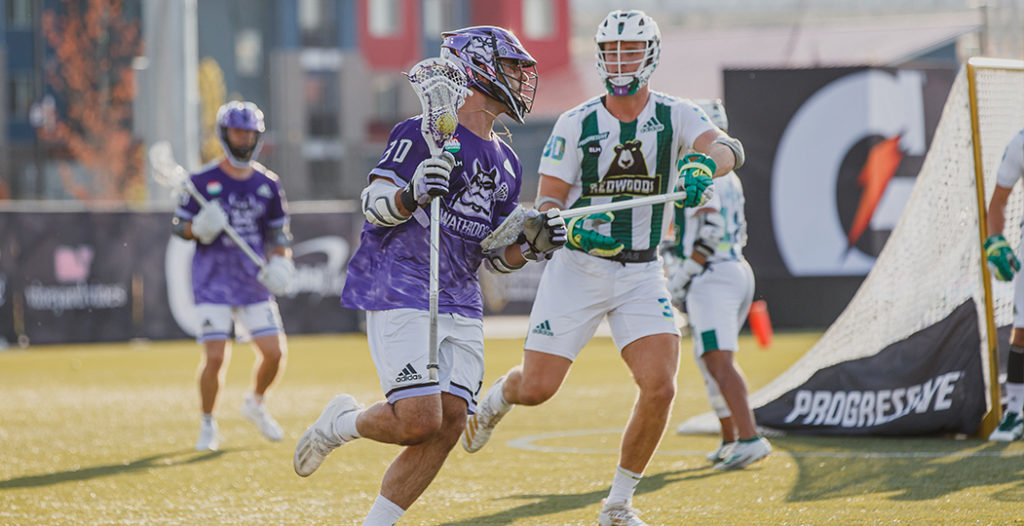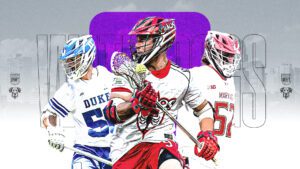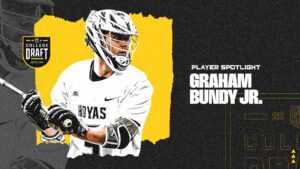
Film Study: Waterdogs’ Off-ball Screens
Ball screens. Seals. Slips. Backdoor cuts. Bee sting picks. C-cuts. Picking the picker. Tic tac toe ball movement. The Waterdogs offense featured everything – except for finishing – in 2020.
Head coach Andy Copelan’s inaugural squad led PLL in assist rate (i.e. the percentage of shots that are assisted) at 57.6%. That’s a lofty number (league average is 48.9%), and not purely a product of playing fast and in space; the Waterdogs’ settled assist rate (52.4%) was still best in the league and comfortably above league average (41.0%).
Unselfishness is an understatement. The Waterdogs generated 4.2 multiple-pass, settled shots per game – twice as many as Chaos (2.1), Atlas (1.8), and Archers (1.7). Teammates turned down good shots to hunt great shots. That ball movement – blended with off-ball movement like this seal-and-roll by Drew Snider – regularly beat recovering defenses.
Drew Snider seals and rolls to the inside as the ball moves from Kieran McArdle to Christian Cuccinello to Snider.@PLLWaterdogs @dsnides23 @kieranmcardle6 @CUCCI_MANE30 pic.twitter.com/wG7odIR4br
— PLL Highlights (@PLLHighlight) August 5, 2020
Snider has a knack for pulling weakside two-on-one advantages out of a hat. The defense didn’t even double team Kieran McArdle on the goal above – and there’s no double team on the horizon here against Atlas. Snider sees the crease is open, and rather than attempt to backdoor his defender who is staring right at him, he sets a bee sting pick for Ben McIntosh – and Zach Currier hits McIntosh in stride.
As Ben Reeves and Zach Currier run a two-man game on the lefty wing, Drew Snider sets a pick on the righty wing to spring Ben McIntosh free.@PLLWaterdogs @CachZurrier @dsnides23 @BenMc90 pic.twitter.com/FgrRCaWI6T
— PLL Highlights (@PLLHighlight) July 27, 2020
Copelan constructed his roster with that type of off-ball movement in mind. Snider and Connor Kelly set several picks like this in a Whipsnakes uniform last summer. McIntosh and Wes Berg are savvy screeners; this stuff is part of the Canadian high school curriculum.
“Away from the ball, it’s not movement for the sake of creating movement,” said Copelan. “There needs to be purposeful movement whether you’re trying to cut to open space yourself or you’re trying to go ahead and seal to create a little bit of friction for one of your teammates or you’re trying to seal the slide guy.”
Kelly tries to seal the slide here. Michael Simon gets through – but Kelly doesn’t quit. He continues to work for the ball, and the ball finds him.
The Waterdogs draw a double on the two-man game and as the ball moves from Berg to McIntosh to McArdle to Kelly, Kelly screens the close out and works to the ball.@PLLWaterdogs @wes_berg @BenMc90 @kieranmcardle6 @connor21kelly pic.twitter.com/iDSnV8yZ4E
— PLL Highlights (@PLLHighlight) August 4, 2020
Connor Kelly attempted more stepdown shots (5-for-22, 22.7% off the catch) than anyone on the team (and second most in the league behind Will Manny). He shot more – and began to hit a rhythm – in the postseason when Copelan moved him to attack. It’s unfair to compare Kelly’s catch-and-shoot percentage to a doorstep dunker. A big chunk (7 of those 22 catch-and-shoot looks) of his attempts were from beyond the arc. He takes tougher shots than most, but he needs to hit more; everyone on this team does.
The Waterdogs offensive octet of Kelly, Snider, McArdle, McIntosh, Berg, Ben Reeves, Ryan Drenner, Christian Cuccinello, and Danny Eipp shot 21.8% (19-for-87) off the catch. That same group finished 32.6% of their assisted attempts in 2019.
If those eight had shot as well as they did in 2019, then the Waterdogs would’ve added 9.4 goals – enough to swing them from a minus-6 differential to a plus-3. Some of those misses were bad pipe luck…
Drew Snider seals the defender, then cuts to the open crease.@PLLWaterdogs @dsnides23 pic.twitter.com/Za19TZlOXf
— PLL Highlights (@PLLHighlight) August 25, 2020
…but that doesn’t explain all of it.
Two theories: Either the Waterdogs missed an elite playmaker or their shooting percentage was way lower than expected and is bound for some serious regression.
My lukewarm answer: Both theories are true to a degree. Although much of the Waterdogs’ offensive identity was the absence of an alpha, establishing a dodging hierarchy helps in close games (see: Matt Rambo in the 2019 Championship). Reeves never asserted himself in that role. McArdle and Cuccinello split dodging duties and had the offense humming without overcarrying.
There will be primary playmakers available in the draft. Copelan could have his choice of Michael Sowers (Duke) or Jeff Teat (Cornell). He’s guaranteed a shot at one, depending on the Atlas’ decision at #1.
Teat would fit wonderfully. He can dominate the ball when needed, but also takes a backseat when defenses try to shut him off. Sowers is an explosive, pass-first presence at X. Containing him in a big-little without switching is impossible. Princeton produced short-stick matchups on command, and Sowers roasted them. The Waterdogs could create tasty mismatches for Sowers after trapping opposing offensive midfielders on defense.
Regarding the second theory, there’s a chance that the Waterdogs’ low assisted shooting percentage is akin to baseball’s BABIP (batting average on balls in play). A consistently high or low BABIP is unsustainable. Pitchers with a high BABIP during one season generally improve the following year. It’s easier to conceive that this team – one that consistently creates quality, assisted looks – will break out of its shooting slump than it would be for a team that struggles to create catch-and-shoot looks altogether.
Opposing goalies saved 60.7% of the Waterdogs’ assisted shots. Is that sustainable?
Drew Snider draws a slide, leaving a 2-on-1 on the weakside where Connor Kelly screens for Wes Berg.@PLLWaterdogs @dsnides23 @connor21kelly @wes_berg pic.twitter.com/bflhQux12G
— PLL Highlights (@PLLHighlight) August 25, 2020
League average save percentage against assisted shots is 48.3%. That mark – 60.7% – seems flukey. It could be a product of a small sample size. Over a full season, that number might drop.
Nobody questioned the talent on this Waterdogs roster entering the Championship Series. But the chemistry and ball movement wowed, even for those of us with high expectations. They’re on to something. Bottling up and preserving this unselfish culture of cutting and passing as the pack continues to build should be Copelan’s top priority.






Pingback: linh tiên song đằng tố
Pingback: exchange online fiyat
Pingback: it danışmanlık ücretleri
Pingback: ซ่อมรถบรรทุก
Pingback: good site to buy dumps with bin
Pingback: บาคาร่า1688
Pingback: phygital strategy
Pingback: คาสิโนออนไลน์เว็บตรง
Pingback: Webcam Sexo Modelos Famosas
Pingback: nova88
Pingback: escort girls
Pingback: buy Magic Mushrooms online
Pingback: ตัดกราม
Pingback: mushroom for sale